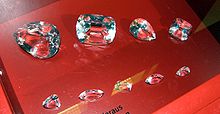Cullinan diamond
The Cullinan diamond is the largest diamond ever found . It was discovered in South Africa in 1905 and weighed 3106.75 carats (621.35 g) in its raw state .
Find
The diamond was discovered at the Premier Mine in Cullinan , 38 km east of Pretoria, during a routine inspection by the mine’s production manager , Frederick Wells , on January 26, 1905. The Cullinan Diamond was found just nine meters below the surface. It was named after the mine owner Thomas Cullinan . The small town of Cullinan is also named after the mine owner. This diamond mine is still in operation there today and has now reached a depth of 763 meters. There are also underground tours for visitors offered daily. The Premier Mine is the most important and sought-after employer in the entire Cullinan area .
After the British colony of the Transvaal had been granted internal self-government at the end of 1906, Prime Minister Louis Botha proposed to the colony’s parliament in August 1907 that the rough diamond be bought up in order to present it to the British King Edward VII as an expression of gratitude and appreciation . This proposal was accepted and the diamond was then presented to the king on the occasion of his 66th birthday on November 9, 1907 at his country estate in Sandringham .
origin
From the composition of inclusions in the world's largest diamonds, scientists have concluded in a new study that these diamonds and thus also the Cullinan diamond must have formed at least 250 kilometers to 750 kilometers deep in the earth's mantle in the middle of a molten metal. Apparently, droplets of this molten metal were trapped in the diamond during the crystallization of carbon under high pressure.
cleavage
In Amsterdam , the rough diamond was split into 105 stones by the cutter Joseph Asscher, brother of Abraham Asscher , in 1908, of which nine large and 96 small pieces. The nine large diamonds are now part of the British Crown Jewels and are located in the Tower of London .
Cullinan I.
The largest stone weighs 530.2 carats (106.04 g) and is known as the Great Star of Africa ( Great Star of Africa become known). It was ground pear-shaped / teardrop-shaped and placed in the royal scepter of King Edward VII . incorporated. It measures 53 × 44 × 29 mm and has 76 facets (including the culet and table). As a special feature, the diamond can be removed from the scepter and worn as a pin or pendant. Queen Alexandra wore it together with Cullinan II for the first time to the opening of parliament in 1909 as a brooch.
Cullinan II
Cullinan II (also Smaller Star of Africa ) ( Lesser Star of Africa ) is a cushion shaped cut diamond, weighing 317.4 carats (63.48 g). It was placed in the middle of the front plate of the British Imperial State Crown .
Cullinan III
Cullinan III weighs 94.4 carats (18.88 g) and has been sanded pear-shaped / teardrop-shaped. He joined Queen Mary's crown in 1911 with Cullinan IV . Cullinan III and IV can be worn together as a pendant / brooch.
Cullinan IV
Cullinan IV weighs 63.6 carats (12.72 g) and was ground square. It is now in the ribbon of Queen Mary's Crown.
Rest
- Cullinan V: 18.5 carats (3.7 g); today in a brooch
- Cullinan VI: 11.5 carats (2.3 g)
- Cullinan VII: 8.8 carats (1.76 g); today in a brooch
- Cullinan VIII: 6.8 carats (1.36 g); today in a brooch
- Cullinan IX: 4.39 carats (0.878 g); today in a ring
Trivia
Transporting the stone was a major problem because there were strong fears that it would be stolen. A large number of security guards were incognito on the ship that was rumored to be carrying the stone. Nevertheless, only one copy was transported, the original stone was simply sent to England by post.
In August 2007, the news of the discovery of a diamond weighing around 7,000 carats, almost twice as heavy, in the northwestern province of South Africa caused a stir. The alleged sensational find, however, turned out to be a fake in the form of a piece of plastic just over a month later.
The Rolls-Royce Cullinan , launched in 2018, is named after the diamond.
See also
Web links
- Special exhibition historical diamonds - replicas from the crystal museum Riedenburg ( TU Bergakademie Freiberg )
Individual evidence
- ^ The New York Times : $ 1,000,000 Gem for King, August 20, 1907, and Big Gem for the King. Cullinan Diamond Presented to Edward as a Birthday Gift dated November 10, 1907
- ^ EM Smith, SB Shirey, F. Nestola, ES Bullock, J. Wang, SH Richardson, W. Wang: Large gem diamonds from metallic liquid in Earths deep mantle. In: Science. 2016, Volume 354, No. 6318, P. 1403, DOI: 10.1126 / science.aal1303 .
- ^ Joan Younger Dickinson: The Book of Diamonds. Crown Publishers, New York 1965, ISBN 978-0-486-41816-2 , p. 110 ( limited preview in Google Book Search).
- ↑ Der Standard : Rumors of the Discovery of the World's Largest Diamond . dated August 27, 2007
- ↑ World's largest uncut diamond denounced as plastic fake. The Guardian, October 6, 2007, accessed April 7, 2016 .
